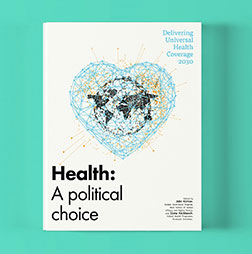The G7 should prioritise financing for disaster risk reduction
In 2023, Canada experienced one of its worst disasters on record – massive wildfires that destroyed an area larger than England and blanketed the skies with smoke for months. As one Canadian scientist put it, “the word ‘unprecedented’ doesn’t do justice to the severity of the wildfires”.
Unfortunately, this trend has continued with new disaster events breaking records around the world, including the recent California wildfires in the United States, which are estimated to be the most expensive disaster in the country’s history.
And although disasters affect all countries, it is the poorest countries that are the most affected, simply because they lack basic protections such as early warning systems.
This leads to disasters that are deadlier, with the least developed countries experiencing disaster mortality rates that are nearly three times higher than the global average. Their disasters are also more expensive relative to their gross domestic product, which pushes people further into poverty, and which is a driver of irregular migration.
Support for the most vulnerable
The United Nations Office for Disaster Risk Reduction exists to help countries avoid the worst effects of disasters. Guided by the globally adopted Sendai Framework for Disaster Risk Reduction, we not only set the standards for disaster risk reduction, but also mobilise countries and organisations for action. This includes capacity building to help authorities understand the disaster risks they face and to design and implement strategies to counter them.
Recently, there has been growing recognition of the importance of this work in economic forums. In 2023, the G7 Hiroshima Leaders’ Communiqué cited UNDRR, the Sendai Framework and the need to “accelerate international disaster risk reduction cooperation”. And at the Apulia Summit last year, the G7 launched the Adaptation Accelerator Hub to support the most vulnerable countries. The G20 has also taken important steps to institutionalise resilience building by setting up a dedicated working group, which is now in its third year.
This attention to disaster risk reduction is welcome and long overdue given the strong link between disasters and economic prosperity. The growing cost of disasters is one aspect of this link, but there are two other equally important aspects, which often do not get enough attention.
First, how can we ensure that economic development itself does not inadvertently lead to more disasters?
Addressing this concern is at the heart of the Sendai Framework and its push for ‘risk-informed development’. In practical terms, it means ensuring we do not jeopardise lives and throw away good money building homes, power plants and factories in areas known to be hazard-prone without taking risk reduction measures. Such measures include strengthening early warning systems, reinforcing infrastructure to be disaster resilient and using the surrounding nature to create flood buffers.
Closing the disaster finance gap
This brings me to the second aspect – funds are needed to implement these measures.
Indeed, one of the biggest hurdles facing developing countries in reducing disaster impacts is the lack of funding to put national disaster risk reduction strategies into motion. To overcome this hurdle, countries must dedicate a larger amount of funding in their national budgets for disaster risk reduction. This means ring-fenced funding for disaster risk reduction in addition to funding within sectoral budgets for resilience building. And internationally, we need to see greater funding through official development assistance.
According to internal research by UNDRR, between 2019 and 2023, only about 2% of all ODA contributed to disaster risk reduction objectives. This is a miniscule amount considering the benefits that such investments generate. According to the World Bank, every $1 invested in making infrastructure disaster resilient in developing countries saves $4 in reduced disruptions and economic impacts.
That is why we have made increasing finance for disaster risk reduction a key priority this year, both in the context of the Global Platform for Disaster Risk Reduction, which we convened on 2–6 June 2025, in Geneva, Switzerland, and as our top advocacy theme for the International Day for Disaster Risk Reduction on 13 October.
I hope the G7 leaders, as representatives of the world’s largest economies, take up this topic as a priority this year, both to save lives and to protect economic prosperity.












